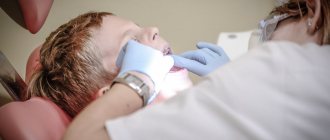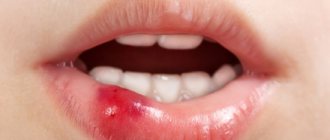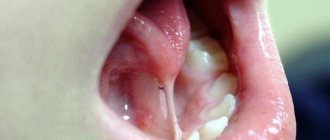Causes of thrush in a child’s mouth
The disease can appear in infants literally from birth - in the first week of life. Its causative agent is the yeast-like fungus Candida. This fungus lives in the body constantly and, with good immunity, does not cause any harm, but when some disruptions occur, the disease develops, and then treatment for candidal stomatitis in children cannot be avoided.
The disease can be caused by:
- vaginal candidiasis of the mother (the child becomes infected with the fungus while passing through the birth canal);
- long-term use of antibiotics;
- the presence of any diseases, for example, ARVI;
- teething;
- improper oral hygiene of the baby or lack thereof.
Regardless of the causes of formation, treatment of thrush in newborns should be carried out under the supervision of a medical specialist.
Causes
The main cause of the disease is infection with the Candida fungus, an opportunistic pathogen that is widespread among humans and animals. Candida is a yeast-like unicellular fungus that is part of the normal microflora in a significant proportion of healthy people. Most often it can be found on the surface of various mucous membranes of the body, for example, in the intestines, mouth, pharynx and tonsils. Today, about 150 varieties of this microorganism are known, 20 of which are capable of causing diseases in humans. The destructive effect of Candida on the mucous membranes and other tissues of the human body is due to the release of a large number of enzymes that break down proteins, fats and other cell components. As a result of this, symptoms characteristic of candidiasis such as burning, dryness, and soreness occur.
When unfavorable conditions occur, Candida becomes covered with a special protective shell, which helps the fungus survive in the external environment and travel from host to host. Infection can occur in various ways - airborne, household contact, intrauterine. Newborn children are infected, as a rule, from medical personnel, or during childbirth, when passing through an infected birth canal.
At an early age, the child’s body does not have a developed immune system, if only for the simple reason that he has had virtually no contact with infectious agents and has not developed the appropriate antibodies. This is why children under one year of age are especially prone to developing candidiasis. However, this disease also occurs in older children. In this case, its appearance and development is often preceded by the formation of multiple carious lesions of the teeth. Caries, which is a constant source of infection, contributes to the weakening of local and general immunity, resulting in the rapid and active proliferation of opportunistic and pathogenic microflora. This category also includes various fungi of the genus Candida and fluorosis.
Factors that can provoke the development of candidiasis in a child’s mouth are also various concomitant diseases, such as diabetes mellitus, diseases of the gastrointestinal tract, acute or chronic infections, and other somatic ailments. Poor oral hygiene, taking antibiotics, hormones and immunosuppressants, and insufficient or unbalanced nutrition also increase the risk of developing candidiasis.
For active reproduction of the fungus, certain conditions are necessary - in particular, this microorganism is most active at temperatures from 30 to 37 degrees Celsius. The level of acidity that is optimal for the growth of Candida occurs in a person’s mouth when consuming large amounts of sweets, flour and other foods containing many simple carbohydrates.
Symptoms of stomatitis in newborns
As a rule, candidal stomatitis in children begins asymptomatically, so the child does not show concern. As the disease progresses, his behavior changes - the baby refuses to eat and becomes capricious. Due to the active proliferation of the fungus, the taste of food changes, which may explain the lack of appetite.
Pronounced signs that treatment of candidal stomatitis is required in children are:
- a whitish, cheesy coating in the oral cavity - it is especially clearly visible in the morning, after waking up;
- sour breath;
- swelling and redness of the gums.
Candidal stomatitis in children has three degrees of severity. In mild and moderate forms of the disease, the white coating is easily removed, but at the same time areas of bright red mucous membranes are exposed. In severe form, the plaque is already denser. And since it is fused to the mucous membrane, it is quite difficult to remove. And if this succeeds, an eroded mucous membrane with bruises opens. Thrush in a baby’s mouth is usually clearly visible in the early stages, so prompt consultation with a doctor can prevent the development of complications.
Treatment of candidal stomatitis in children must be started in a timely manner, otherwise complications in the form of a secondary infection and the gradual spread of the fungus throughout the child’s body cannot be avoided.
Candidal stomatitis can be identified by the symptoms in the following photos:
Candidiasis (thrush) in children
The following forms of thrush are distinguished:
- Thrush of the mucous membranes (oral cavity, tongue, gums, pharynx, tonsils, trachea, larynx, red border of the lips, corners of the mouth, teeth, vagina, vulva).
- Thrush of the skin and its appendages.
- Thrush is visceral, systemic.
- Allergic manifestations of thrush in children.
Candida infection most often manifests itself as thrush . It most often affects newborns, infants and preschoolers. The main symptom is curdled white deposits on the mucous membrane of the cheeks, gums, and palate. The overlays are initially located pointwise and then merged. Easy to remove. If treatment is not carried out in time, the overlays become denser and become grayish-dirty in color, they are increasingly difficult to remove, and the mucous membrane bleeds after removing the overlays. The general condition is not significantly disturbed if the children in the first days of life are not sick with anything else.
If the infection affects the mucous membrane of the tongue, then not only fungal overlays appear, but also areas without papillae. Swelling of the tongue, focal hyperemia and striations with furrows are recorded. The tongue becomes more sensitive to spicy and hot foods. Patients may complain of a burning sensation and dry mouth. It is difficult for infants to suckle milk, which is why they have difficulty eating.
Candidiasis tonsillitis , as a rule, appears against the background of candidiasis of the oral mucosa. It manifests itself by the appearance of loose whitish deposits on the surface of the tonsils, which can be removed with a spatula without effort. The tissue of the tonsils is practically unchanged. The child's general condition is almost normal. The temperature is elevated only if candidiasis of the tonsils occurs against the background of ARVI.
When diagnosed, fungal tonsillitis is distinguished from localized diphtheria of the pharynx by the absence of fever, the absence of hyperemia of the tonsils, and the normal size of the regional lymph nodes.
Candidiasis infection of the mucous membranes of the oral cavity and tonsils can spread to the mucous membrane of the larynx, trachea, and esophagus. In such cases, symptoms such as hoarseness and difficulty breathing appear.
Candidiasis of the corners of the mouth (jam) in children occurs in rare cases. It is recognized by cracks in the corners of the mouth and erosion with perifocal infiltration. Usually both corners of the mouth are affected. The disease is distinguished from streptococcal infection - with it the inflammatory reaction is more pronounced.
Candidiasis of the red border of the lips (in the literature referred to as cheilitis) is often combined with candidiasis of the oral mucosa and erosions of the corners of the mouth. The red border of the lips swells and becomes hyperemic. The patient complains of dryness and burning of the lips. The disease lasts a long time.
Vulvovaginal candidiasis is symptomatically manifested by white discharge. The mucous membrane of the genital organs is moderately hyperemic, with loose cheesy deposits of a whitish or grayish tint visible on it. Rarely does it have superficial erosions. Overlays can be found in some cases on the vaginal mucosa and cervix. The external genitalia are very itchy and there is a burning sensation.
Intertriginous candidiasis occurs most often in infants in the area of large skin folds. The skin is hyperemic or eroded, and maceration of the stratum corneum is observed on it.
Smooth skin candidiasis in infants occurs mainly as a result of the spread of intertriginous candidiasis from skin folds. Candidiasis of the scalp is rare in children .
Chronic generalized granulomatous candidiasis is typical for children who are malnourished, suffer from gastrointestinal disorders, and bronchitis. The disease begins with oral thrush, then the process causes glossitis, cheilitis and seizures, which are treated poorly and ineffectively. In many cases, deep dental caries develops. The process subsequently affects the skin on the face and under the hair, and later on the torso, arms and legs. The appearance of hyperemic spots with a bluish tint, with infiltration and superficial peeling is recorded. These epidermal lesions gradually become granulomatous. Papules and tubercles appear, many of which are covered with a yellow-brown crust, under which papillomatous growths form. In almost all cases, the disease affects the nails and nail folds.
Microscopy results show the presence of yeast-like fungi in the urine and feces, and in some cases in the blood. Serological reactions in all sick children are positive.
In recent years, visceral candidiasis most often manifests itself as pulmonary candidiasis, which appears as a result of long-term therapy with antibiotics that were prescribed incorrectly. Pulmonary candidiasis manifests itself with a variety of symptoms. The disease can be acute or take a protracted, chronic nature. Relapses and exacerbations are possible.
Abscessing and cavernous forms of candidiasis pneumonia, pleurisy, which are difficult to distinguish from tuberculosis based on symptoms and radiographs, have been recorded in the literature.
Gastrointestinal candidiasis is distinguished by the fact that the deposits are abundant, sometimes completely fungal, they can cover the entire mucous membrane of the esophagus. Symptoms such as progressive dysphagia and the inability to swallow food are noted. Babies stop reaching for their mother's breasts and vomit. In especially severe cases of the disease, due to the massiveness of the deposits on the esophagus, its lumen may narrow, or even obstruction may occur. Histologically, deep destruction of the esophagus is revealed. In most cases, damage to the esophagus is also accompanied by thrush of the oral mucosa, which provides clues to diagnosticians.
Gastric candidiasis is a rare disease in children. It can only be detected by obtaining histological examination data. On the affected part of the stomach, hyperemia of the mucous membrane and small erosions are noted. Typical overlays, as with thrush, are quite rare.
With intestinal candidiasis, symptoms of enterocolitis or colitis, intestinal colic, and bloating are recorded. The stool is watery and may contain blood. The disease lasts a long time, there are relapses.
Damage to the urinary tract by Candida fungi manifests itself as urethritis, pyelitis, cysts, nephritis.
Generalized candidiasis in children can lead to endocarditis with damage to the heart valves or meningitis and meningoencephalitis, which is typical mainly for infants and preschoolers. With candidiasis meningitis, mild meningeal symptoms and a slight increase in temperature are observed. The disease progresses sluggishly, torpidly, and relapses are possible.
The most severe manifestation of candidal infection is candidal sepsis . This form of the disease occurs mainly in babies from 0 to 6 months. Before the disease, as a rule, there is another serious illness or microbial sepsis, which is complicated by an associated superinfection with the Candida fungus.
Candidiasis can spread through the oral mucosa to the esophagus, intestines or to the larynx, bronchi and lungs and end in sepsis . Also from the oral mucosa, Candida can spread through the blood. The symptoms of candidal sepsis are almost similar to ordinary bacterial sepsis. Diagnosis is made by isolating Candida from the blood of a sick child.
Clinical treatment
The success of treatment of candidal stomatitis in children can only be said if all sources of infection have been completely eliminated. When the cause of oral disease is the use of antibiotics, in parallel with general treatment, a course of antifungal therapy may be prescribed.
The principle of treating candidal stomatitis in children comes down to creating an alkaline environment in the oral cavity - it is this pH value that is detrimental to fungi. In addition, in an alkaline environment, most pathological microorganisms die, including those that cause carious tooth decay.
The child’s oral cavity can be treated with a solution of baking soda (the optimal concentration will be determined by the attending physician). The procedure for treating candidal stomatitis in children is quite simple: a gauze swab soaked in a solution is used to treat the oral mucosa of the gums and cheeks.
In severe cases, your dentist may prescribe oral medications.
The Doka-Dent dental clinic provides quick and safe diagnostics for effective treatment of stomatitis in infants and older children. Branches in Moscow are located at two addresses:
- Teply Stan district, Leninsky Prospekt, building 131, 1st and 2nd floor. One minute from Troparevo metro station in a building located between Leninsky Prospekt and Academician Bakulev Street.
- Tverskoy district, 1st Tverskaya-Yamskaya, building 27, 2nd floor. Three minutes from any exit from Belorusskaya station in a building located between the first Tverskaya-Yamskaya and the first Brestskaya streets.
Specialists from both clinics conduct examinations free of charge and help urgently prevent the development of complications and the spread of the disease!
Pathogenesis
Normally, protection against mycotic (fungal) infection is provided by cellular immunity, namely the activity of T-lymphocytes and phagocytes (neutrophils, macrophages and monocytes). Phagocytic cells recognize, engulf and digest fungal cells. With a decrease in immunity and exposure to predisposing factors, phagocytes capture, but are not able to “digest” the fungus of the genus Candida - incomplete phagocytosis develops.
A disruption of the immune response leads to adhesion (attachment) of the fungus to the surface of the mucosa, and local inflammation occurs at this site. Candida then multiplies and penetrates the submucosa and other underlying tissues, disrupting their structure. Due to the presence of specific enzymes, Candida fungi are capable of causing tissue necrosis, which only enhances their adhesive properties and accelerates penetration.
Fungi of the genus Candida differ in their pathogenic activity depending on the species. Candida albicans is considered the most pathogenic, which is capable of changing its phenotype (as conditions for its habitat worsen, it changes from yeast to mold form), receptors and antigens.
Chronic candidiasis infection leads to sensitization (sensitivity) of the body to the fungal antigen and causes the formation of autoantibodies that destroy their own cells - the cells of the human body.
Treatment
Some people mistakenly believe that candidiasis needs to be treated with antibiotics - this is not true at all. Antibiotics are effective only against bacterial organisms, and thrush is a fungal infection.
The disease is treated with local therapy aimed at destroying pathogens and producing a bactericidal and disinfectant effect.
Medication method
"Stomatidin" . Quickly copes with mushrooms that have a yeast-like structure. You need to use the product to treat the affected areas 2 times a day.
"Candide" (solution) . The active substance destroys the membrane of fungi, completely destroying them and suppressing the growth of pathogenic bacteria. The course of treatment is at least 10 days. It is important to continue therapy for the recommended period, even if visible signs of the disease have disappeared.
Doctor's advice
If you observe hygiene products for your child, you should use baby products – soap, foam, etc. Regular soap is too aggressive - it easily washes away representatives of normal microflora from the baby’s skin, and the resulting niche can be occupied by a fungus. It is easy to transfer it from the skin to the oral mucosa - any household item, the hands of mother and child, things can contribute to this. The child should not be sterile, so there is no need to get carried away with the excessive use of even children's cosmetics.
Victoria Druzhikina Neurologist, Therapist
"Diflucan". The drug can be used in newborns starting from the 11th day of life. Until the age of 1 month, the product is used only for intravenous infusion. This measure is usually a last resort and is used only when necessary.
"Nystatin" . Destroys fungal infections, relieves inflammation and does not irritate the baby's mucous membranes. The duration of use of the medicine is 7-10 days (at a dosage of 1 drop on each side). The drug is applied to a cotton swab, after which the inner surface of the cheeks is treated.
Brilliant green (green) . The use of brilliant green is very effective in the treatment of thrush in infants. A small amount of brilliant green should be applied to a cotton pad and thoroughly treated the inflamed areas. Usually two procedures are enough to completely solve the problem.
If you cannot treat the oral cavity with cotton swabs, you can apply brilliant green to the pacifier or pacifier. To achieve a therapeutic effect, 1 minute of active sucking is enough.
The safest drug is chamomile. Treatment with chlorhexidine bigluconate solution 0.05% is possible. To do this, moisten the cotton wool, wring it out and carefully wipe the affected area. Make sure that the drug does not flow from the cotton wool into the child’s throat. You can process 2-3 times per day. If the place is hard to reach, then instead of the mucous membranes of the mouth, you can wipe the pacifier before giving it to the child. 2-3 times a day. Peroxide solution should not be used to avoid burns.
Victoria Druzhikina
Neurologist, Therapist
Traditional methods
The following folk remedies are effective in treating oral thrush:
- Soda . After feeding, treat the baby's mouth with a soda solution (if the baby is bottle-fed, do the same procedure with the nipples).
- Tincture of calendula. Suitable for slow douching or local surface treatment.
- Chamomile decoction . Use a moistened cotton swab to treat the oral cavity several times a day (5-6 times).
Stages of the disease
The disease begins at a mild stage, when reddish spots are barely visible on the mucous membrane, soon giving way to a cheesy white coating. At this stage, the child does not feel much discomfort, and the infection itself is easily treatable. If treatment is not carried out, then thrush enters the middle stage, when spots and plaque merge and form islands that fill almost the entire oral cavity. At this stage, when trying to clean the plaque, bleeding ulcers appear. The child becomes restless, especially during sucking. In the severe stage of thrush, bleeding increases and quite intense pain appears. Fever often develops and bowel movements are disrupted. It is advisable to treat this form of thrush in a hospital setting.
According to the course of the disease, acute and chronic forms are distinguished. The acute form is more common, and the chronic form is usually a companion to other diseases. In the acute form, the plaque is white, cheesy, with a tendency to expand the affected areas up to the corners of the mouth. In addition to discomfort, the child may experience increased temperature, enlarged and painful lymph nodes (usually submandibular). For diagnosis, the doctor will take a scraping of the plaque and, upon examination, will find in it epithelial cells, food debris, fibrin fibers and, of course, the pathogen itself.
In the chronic form, the coating is yellowish or brown and more dense. Touching the affected mucous membrane causes severe pain. There is swelling around the lesion, and nearby lymph nodes are also enlarged. As with the acute form, the child’s behavior changes - older children complain of pain when eating, and infants become whiny and restless. This form is difficult to treat, so it is important to prevent acute thrush from becoming chronic.
Complications from thrush are usually associated with disruption of the digestive tract and respiratory system, however, there is a risk of developing diseases of other organs. If adequate treatment is not carried out in time, thrush can develop into a chronic, recurrent form.










